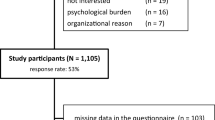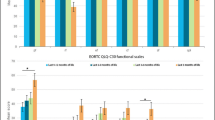Abstract
Background
Cancer leads to a complicated pattern of change in quality of life (QoL).
Objective
The aims of this study were to assess the impact of treatment-related side effects on QoL in cancer patients and to explore which other factors, and to what extent, contribute to explain low QoL scores.
Methods
One hundred twenty-three cancer patients receiving chemotherapy completed the self-administered questionnaires (Medical Outcomes Short-Form-36 (SF-36) and 12-item General Health Questionnaire). Multiple regression analyses were conducted with the SF-36 physical component summary (PCS) and SF-36 mental component summary (MCS) scores as the dependent variables and demographic and clinical factors as independent variables.
Results
Seventy-two percent of patients experienced treatment-related side effects, and 32% resulted positive for psychiatric diseases. Two multivariate analyses showed that worse PCS scores, like worse MCS scores, were significantly and independently predicted by treatment-related side effects (odds ratio (OR) = 5.00, 95%CI 1.29–19.45; OR = 8.08, 95%CI 2.03–32.22, respectively) and changes in health over the last 12 months (OR =2.34, 95%CI 1.47–3.76; OR = 3.21, 95%CI 1.90–5.41, respectively), after adjustment for age, gender, years of school, time from cancer diagnosis, and psychiatric disease.
Conclusions
Given the new emphasis on QoL, we suggest that physicians have a responsibility to openly discuss therapy efficacy, prognosis as well as the potential for adverse events with their patients. Changes in health, as perceived by patient, should also be monitored at follow-up.
Similar content being viewed by others
References
Aktas A, Walsh D, Rybicki L (2010) Symptom clusters: myth or reality? Palliat Med 24(4):373–385
Bleiker EMA, Pouwer F, van der Ploeg HM, Leer J-WH, Ader HJ (2000) Psychological distress two years after diagnosis of breast cancer: frequency and prediction. Patient Education and Counseling 40:209–217
Butcher L (2008) Shared decision-making aids improving, winning support among both patients and physicians for treatment choices. Oncology Times 30(10):23–26. doi:10.1097/01.COT.0000320575.58527.86
Cella D (2009) Quality of life in patients with metastatic renal cell carcinoma: the importance of patient-reported outcomes. Cancer Treatment Reviews 35:733–737
Collins ED, Moore CP, Clay KF et al (2009) Can women with early-stage breast cancer make an informed decision for mastectomy? J Clin Oncol 27(4):519–525
Fallowfield L, Ratcliffe D, Jenkins V, Saul J (2001) Psychiatric morbidity and its recognition by doctors in patients with cancer. Br J Cancer 84:1011–1015
Goldberg DP (1972) The detection of psychiatric illness by questionnaire. Oxford University Press, London
Holland JC, Alici Y (2010) Management of distress in cancer patients. J Supp Oncology 8(1):4–12
Keller M, Sommerfeldt S, Fischer C, Knight L, Riesbeck M, Lowe B et al (2004) Recognition of distress and psychiatric morbidity in cancer patients: a multi-method approach. Annals of Oncology 15:1243–1249
Kim HJ, Barsevick AM, Tulman L, McDermott PA (2008) Treatment-related symptom clusters in breast-cancer: a secondary analysis. Journal of Pain and Symptom Management 36(5):468–479
Kirkova J, Davis MP, Walsh D, Tiernan E, O’Leary N, LeGrand SB et al (2006) Cancer symptom assessment instruments: a systematic review. J Clin Oncol 24(9):1459–1473
Kirkova J, Rybicki L, Walsh D, Aktas A, Davis MP, Karafa MT (2010) The relationship between symptom prevalence and severity and cancer primary site in 796 patients with advanced cancer. Am J Hosp Palliat Care 28(50):350–355
Kirkova J, Walsh D, Rybicki L, Davis MP, Aktas A, Tao J et al (2010) Symptom severity and distress in advanced cancer. Palliat Med 24(3):330–339
Krespi Boothby MR, Hill J, Holcombe C, Clark L et al (2010) The accuracy of HADS and GHQ-12 in detecting psychiatric morbidity in breast cancer patients. Turk Psikiyatri Dergisi 21(1):49–59
Mehnert A, Koch U (2008) Psychological comorbidity and health-related quality of life and its association with awareness, utilization, and need for psychosocial support in cancer register-based sample of long-term breast cancer survivors. J Psychosomatic Research 64(4):383–391
National Comprehensive Cancer Network (2009) Distress management clinical practice guidelines in oncology, version 1 (www.nccn.org/professionals/physician_gls/f_guidelines.asp#supportive)
Piccinelli M, Bisoffi G, Bon MG et al (1993) Validity and test–retest reliability of the Italian version of the 12-item General Health Questionnaire in general practice: a comparison between three scoring methods. Compr Psychiatry 34:198–205
Porzio G, Valenti M, Aielli F, Verna L, Ricevuto E, Rispoli AI et al (2005) Assessment and treatment of symptoms among Italian medical oncologists. Supportive Care Cancer 13:865–869
Prouse J (2010) The impact of methods of information on chemotherapy-related side effects. Clin J Oncol Nurs 14(2):206–211
Raphael J, Hester J, Ahmedzai S et al (2010) Cancer pain, part 2. Physical, interventional and complimentary therapies; management in the community; acute, treatment-related and complex cancer pain: a perspective from the British Pain Society endorsed by the UK Association of Palliative Medicine and the Royal College of General Practitioners. Pain Med 11(6):872–896
Richardson LC, Wang W, Hartzema AG, Wagner S (2007) The role of health-related quality of life in early discontinuation of chemotherapy for breast cancer. Breast J 13(6):581–587
Rose MS, Koshman ML, Spreng S, Sheldon R (1999) Statistical issues encountered in the comparison of health-related quality of life in diseased patients to published general population norms: problems and solutions. J Clin Epidemiol 52:405–412
Schofield P, Jefford M, Carey M, Thomson K, Evans M, Baravelli C et al (2008) Preparing patients for threatening medical treatments: effects of a chemotherapy educational DVD on anxiety, unmet needs, and self-efficacy. Support Care Cancer 16:37–45
Sioka C, Kyritsis AP (2009) Central and peripheral nervous system toxicity of common chemotherapeutic agents. Cancer Chemother Pharmacol 63(5):761–767
So WKW, Marsh G, Ling WM, Leung FY, Lo JCK, Yeung M et al (2009) The symptom cluster of fatigue, pain, anxiety and depression and the effect on the quality of life of women receiving treatment for breast cancer: a multicenter study. Oncology Nursing Forum 36(4):E205–E214
Spichiger E, Muller-Frohlich C, Denhaerynch K, Stoll H, Hantikainen V, Dodd M (2011) Symptom prevalence and changes of symptoms over ten days in hospitalized patients with advanced cancer: a descriptive study. Europ J Oncol Nursing 15(2):95–102
Streiner DL (2002) Breaking up is hard to do: the heartbreak of dichotomizing continuous data. Can J Psychiatry 47:262–266
Teunissen SC, Wesker W, Kruitwagen C, de Haes HC, Voest EE, de Graeff A (2007) Symptom prevalence in patients with incurable cancer: a systematic review. J Pain Symptom Manage 34(1):94–104
Ware JE, Kosinski M (2001) SF-36 physical and mental health summary scales: a manual for users of version I. (2nd ed.). Quality Metric Incorporated, Lincoln
Yamagishi A, Morita T, Miyashita M, Kimura F (2009) Symptom prevalence and longitudinal follow-up in cancer outpatients receiving chemotherapy. J Pain Symptom Manage 37(5):823–830
Zabora J, BrintzenhofeSzoc K, Curbow B, Hooker C, Piantadosi S (2001) The prevalence of psychological distress by cancer site. Psycho-Oncology 10(1):19–28
Acknowledgments
We would like to thank all the patients who participated in this study.
Authors' disclosure of potential conflicts of interest
The authors have no conflict of interest, financial or otherwise, related to this work.
Author information
Authors and Affiliations
Corresponding author
Rights and permissions
About this article
Cite this article
Mazzotti, E., Antonini Cappellini, G.C., Buconovo, S. et al. Treatment-related side effects and quality of life in cancer patients. Support Care Cancer 20, 2553–2557 (2012). https://doi.org/10.1007/s00520-011-1354-y
Received:
Accepted:
Published:
Issue Date:
DOI: https://doi.org/10.1007/s00520-011-1354-y




